10 Iconic Forts You Must Visit In India
By: Priyanka Maheshwari Tue, 13 June 2023 11:08:01
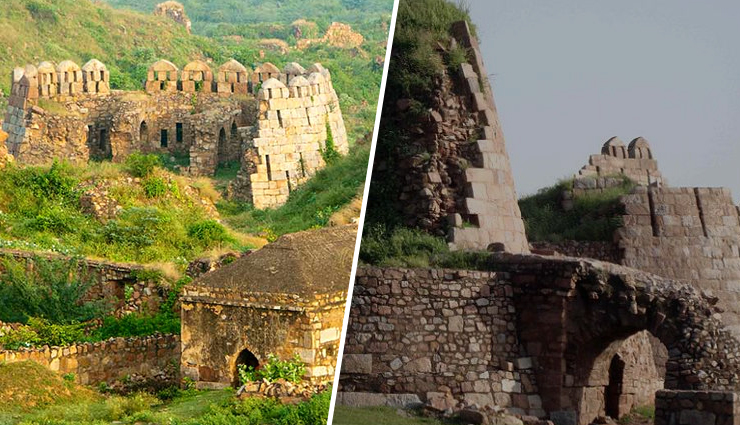
If you have a fondness for historical architecture and enjoy delving into the past, India's splendid forts are sure to delight you. These majestic fortresses spread across the country offer a captivating journey through various historical periods. Almost every state in India boasts at least one enchanting fort, making it an incredible destination for fort enthusiasts.
From Varanasi to New Delhi, a multitude of experiences await you at these forts. They serve as gateways to the bygone eras, allowing you to connect with the triumphs, glories, and even the defeats of past rulers. To assist you in planning your visit, we have curated a list of the top 10 forts in India that are a must-see.
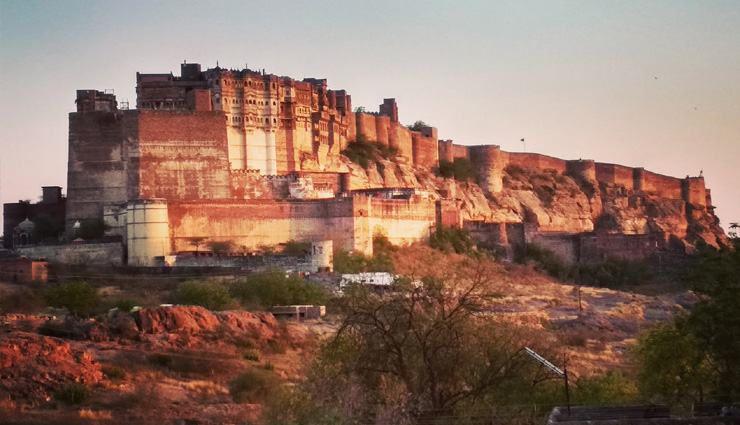
# Mehrangarh Fort, Jodhpur
Mehrangarh Fort is a magnificent fort located in Jodhpur, Rajasthan, India. Perched on a rocky hill, it towers over the city and offers breathtaking panoramic views of the surrounding landscape. The fort is one of the largest and most well-preserved forts in India, known for its imposing architecture and rich historical significance.
Construction of Mehrangarh Fort began in 1459 under the patronage of Rao Jodha, the founder of Jodhpur. The fort's name is derived from the combination of two words: "Mehr," meaning the sun, and "Garh," meaning fort. The name signifies the invincibility of the fort and its association with the lineage of the Rathore dynasty.
The fort is surrounded by massive walls that are several meters thick and rise to a height of around 36 meters. It contains several palaces, courtyards, temples, and museums, each showcasing the grandeur and opulence of the Rajput era. Some of the notable attractions within the fort include:
- Moti Mahal (Pearl Palace): This palace features delicate mirror work and exquisite artwork. It was constructed by Maharaja Sur Singh and served as the private residence of the kings.
- Phool Mahal (Flower Palace): This palace was built by Maharaja Abhaya Singh and served as a pleasure palace for entertainment and celebrations. It displays beautiful frescoes, glasswork, and gold leaf paintings.
- Sheesh Mahal (Mirror Palace): Known for its intricately designed mirror work, this palace is a visual delight. It is believed to have been the private chamber of the queens.
- Chamunda Devi Temple: Situated within the fort complex, this temple is dedicated to the goddess Chamunda, the patron deity of the royal family.
Additionally, the fort houses the Mehrangarh Museum, which showcases an impressive collection of artifacts, including weapons, costumes, paintings, and historical documents. The museum provides insights into the history, culture, and lifestyle of the Rajput rulers.
Mehrangarh Fort has been featured in several movies, including "The Dark Knight Rises" and "The Fall," further adding to its allure. It hosts cultural events and music concerts, such as the Rajasthan International Folk Festival (RIFF), which attracts artists and enthusiasts from around the world.
Visiting Mehrangarh Fort is an immersive experience that allows you to explore the grandeur of Rajput architecture, soak in the rich history of Jodhpur, and enjoy panoramic vistas of the Blue City. It is truly a gem of Rajasthan's cultural heritage and a must-visit destination for history and architecture enthusiasts.

# Gwalior Fort, Gwalior
Gwalior Fort is an impressive fortress situated in the city of Gwalior, in the state of Madhya Pradesh, India. This historic fort holds great significance as it has witnessed the rule of several dynasties and played a crucial role in shaping the region's history. Gwalior Fort is known for its stunning architecture, strategic location, and captivating legends.
The construction of Gwalior Fort is believed to have started in the 8th century, with subsequent additions and renovations made by various rulers over the centuries. The fort stands atop an isolated hill, Gopachal, overlooking the city of Gwalior. Its towering walls and majestic structures showcase a blend of Hindu, Mughal, and Maratha architectural styles.
The fort is accessed through a steep road or a series of rock-cut steps, leading to the Hathi Pol (Elephant Gate), which is the main entrance. As you enter the fort, you will encounter several notable structures and attractions:
- Man Singh Palace: This palace was built by Raja Man Singh Tomar in the 15th century. It exhibits a unique fusion of Hindu and Islamic architectural elements, including intricate carvings, lattice work, and ornamental designs.
- Gujari Mahal: Constructed by Raja Man Singh Tomar for his queen, Mrignayani, this palace has been converted into a museum. It houses a remarkable collection of artifacts, including sculptures, paintings, and archaeological finds from the region.
- Teli-ka-Mandir: This temple is one of the oldest structures within the fort, dating back to the 9th century. It showcases a blend of Nagara and Dravidian architectural styles, with intricate carvings and towering proportions.
- Sas Bahu Temples: These intricately carved twin temples dedicated to Lord Vishnu are a testament to the exquisite craftsmanship of the time. The larger temple, dedicated to Lord Vishnu, is known as the Sas Bahu Temple, while the smaller one is dedicated to Lord Shiva.
- Suraj Kund: This ancient reservoir within the fort complex is said to have miraculous powers. It is believed that a dip in its waters can cure skin diseases.
Apart from these attractions, the fort offers breathtaking panoramic views of the city and the surrounding landscape. The Sound and Light Show held in the evenings narrates the history of the fort and brings the stories of its rulers to life.
Gwalior Fort stands as a symbol of architectural brilliance, military strength, and the valor of the dynasties that ruled the region. It is a must-visit destination for history enthusiasts and travelers seeking a glimpse into India's rich cultural heritage.
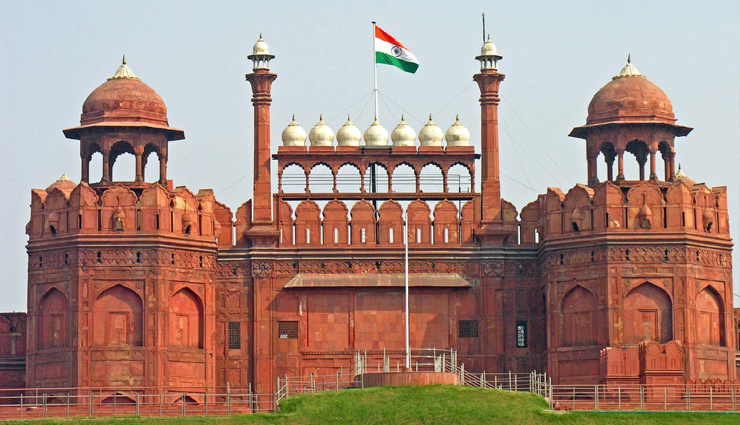
# Red Fort, Delhi
The Red Fort, located in the heart of Delhi, is an iconic historical monument and a UNESCO World Heritage Site. Known for its magnificent red sandstone architecture, the Red Fort (also known as Lal Qila) is a symbol of India's rich history and cultural heritage.
The construction of the Red Fort was initiated by the Mughal Emperor Shah Jahan in 1638 and completed in 1648. It served as the main residence of the Mughal emperors for nearly 200 years and was the ceremonial and political center of the Mughal Empire.
The Red Fort is renowned for its grandeur and architectural brilliance. The fort is surrounded by massive walls that stretch over two kilometers in length. The imposing Lahori Gate is the main entrance to the fort and leads to a large ceremonial courtyard known as the Chatta Chowk, which used to be a bustling market during the Mughal era.
Inside the fort, visitors can explore various impressive structures and attractions:
- Diwan-i-Aam (Hall of Public Audience): This grand hall was the place where the Mughal emperor would address the public and listen to their grievances. The hall features elegant arches and a marble throne.
- Diwan-i-Khas (Hall of Private Audience): This exquisite hall was reserved for private meetings of the emperor with select nobles and dignitaries. It is known for its ornate marble and precious gemstone decorations.
- Rang Mahal (Palace of Colors): This palace was the residence of the emperor's wives and concubines. It is adorned with beautiful frescoes, intricate mirror work, and decorative paintwork.
- Mumtaz Mahal: This palace was named after Mumtaz Mahal, one of Emperor Shah Jahan's favorite wives. It is an elegant structure that showcases delicate carvings and stunning architectural details.
- The Royal Baths: The fort includes the luxurious hammams (baths) where the Mughal emperors used to indulge in bathing rituals.
The Red Fort also serves as the venue for the annual flag hoisting ceremony on Independence Day, celebrated on 15th August, marking India's independence from British rule in 1947. The event is attended by the Prime Minister of India and is followed by cultural performances and a patriotic atmosphere.
Visiting the Red Fort allows you to immerse yourself in the grandeur of Mughal architecture, experience the historical significance of Delhi, and appreciate the cultural legacy of India. The fort stands as a reminder of the Mughal era and is a must-visit destination for history enthusiasts and travelers alike.

# Amber Fort, Jaipur
Amber Fort, also known as Amer Fort, is a magnificent fortress located in Jaipur, the capital city of Rajasthan, India. It is one of the most prominent tourist attractions in the region and a UNESCO World Heritage Site. Amber Fort showcases a splendid blend of Rajput and Mughal architectural styles and is renowned for its grandeur and captivating beauty.
The construction of Amber Fort began in the 16th century under the patronage of Raja Man Singh I, a trusted general of Emperor Akbar. Over the years, subsequent rulers added their own architectural contributions, resulting in a stunning complex that spans over four levels, each with its own courtyard.
Here are some notable features and attractions within Amber Fort:
- Diwan-i-Aam (Hall of Public Audience): This open-air courtyard served as the venue for public gatherings and the ruler's interactions with the common people. The hall features an elevated platform where the king would sit.
- Diwan-i-Khas (Hall of Private Audience): This ornate hall was reserved for private meetings with the king and important dignitaries. It showcases intricate mirror work, stunning paintings, and finely carved marble pillars.
- Sheesh Mahal (Mirror Palace): Known as the "Hall of Mirrors," this breathtaking chamber is renowned for its intricate mirror work. The mirrors are so strategically placed that even a single light can illuminate the entire room.
- Ganesh Pol (Ganesh Gate): This is the main entrance to the private palaces of the rulers. It is an intricately designed gateway with delicate frescoes and vibrant paintings, featuring the image of Lord Ganesha.
- Sukh Niwas (Hall of Pleasure): This hall was designed to offer relief from the scorching heat of Rajasthan. It features an innovative cooling system, with water channels running beneath the floor to keep the environment cool.
- Kesar Kyari Bagh: Located just below the fort, this picturesque garden complex is famous for its beautiful layout of saffron flower beds and geometric patterns. It offers stunning views of the Maota Lake and the fort.
Visitors to Amber Fort can explore the complex on foot or enjoy an elephant ride up the hill to the main entrance. The fort's strategic location on a hill provides breathtaking panoramic views of the surrounding landscapes, including the rugged Aravalli Hills and the serene Maota Lake.
In the evening, the fort hosts a spectacular sound and light show that narrates the history and legends associated with the fort, bringing the rich heritage to life.
Amber Fort is a treasure trove of Rajput history, architectural brilliance, and cultural heritage. Its grand structures, intricate designs, and scenic vistas make it a must-visit destination for travelers seeking to immerse themselves in the splendor of Rajasthan's royal past.
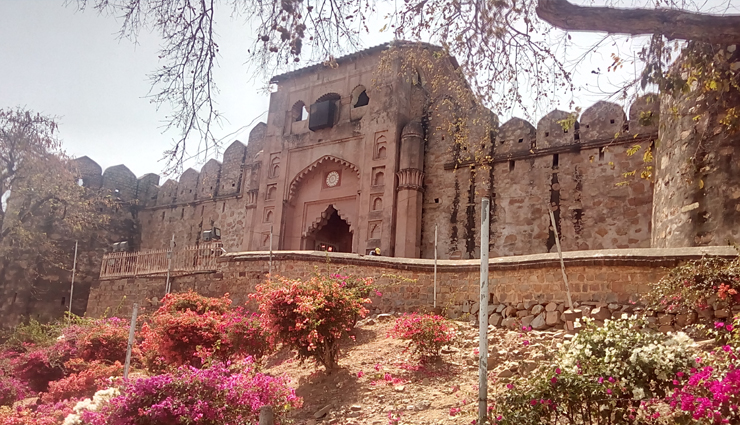
# Jhansi Fort, Jhansi
Jhansi Fort is a historic fort located in the city of Jhansi in the state of Uttar Pradesh, India. It holds great significance as it was the site of the iconic battle fought during the Indian Rebellion of 1857, also known as the First War of Independence. The fort stands as a symbol of bravery, resilience, and the indomitable spirit of Rani Lakshmi Bai, the queen of Jhansi, who played a pivotal role in the rebellion.
The construction of Jhansi Fort dates back to the 17th century, and it was originally built by Raja Bir Singh Deo of the Orchha dynasty. However, the fort underwent several expansions and renovations over the years. The fort is perched on a hilltop, providing a strategic advantage and commanding views of the surrounding area.
Jhansi Fort is known for its imposing architecture and sturdy defenses. It is surrounded by massive walls and bastions, with ten gates providing access to the fort complex. The entrance gate, known as the "Unnao Gate," is particularly significant as it is associated with the valiant defense of the fort during the 1857 rebellion.
Within the fort, there are several structures and attractions that visitors can explore:
- Rani Jhansi Museum: Housed within the fort complex, the museum showcases a collection of artifacts, including weapons, photographs, paintings, and personal belongings of Rani Lakshmi Bai. It offers insights into her life and the rebellion.
- Karak Bijli Tank: This is a historic tank within the fort that was used as a reservoir during the times of the Bundela rulers. It is said that Rani Lakshmi Bai used this tank to store gunpowder during the rebellion.
- Rani Mahal: Located within the fort, this palace was the residence of Rani Lakshmi Bai. Though partially damaged, it still reflects the architectural style of the bygone era.
- Ganesh Mandir: Situated inside the fort, this temple is dedicated to Lord Ganesh. It is a popular place of worship for both locals and visitors.
Jhansi Fort not only offers a glimpse into the historical events that unfolded during the rebellion but also provides panoramic views of the city of Jhansi. It stands as a reminder of the courageous spirit of Rani Lakshmi Bai and her fight for freedom.
Visiting Jhansi Fort allows you to delve into the pages of India's history, pay homage to the brave warriors who fought for independence, and appreciate the architectural splendor of the fort. It is a place of historical significance and a testament to the valor and sacrifice of the people who fought for their rights.

# Chittorgarh Fort, Rajasthan
Chittorgarh Fort, situated in the city of Chittorgarh in Rajasthan, India, is one of the largest and most renowned forts in the country. With a rich history spanning over centuries, Chittorgarh Fort stands as a symbol of Rajput valor, sacrifice, and resilience. It is a UNESCO World Heritage Site and attracts visitors from all over the world.
The construction of Chittorgarh Fort is attributed to the Maurya dynasty in the 7th century, and it has since been expanded and fortified by various rulers, including the Sisodia Rajputs of Mewar. The fort is strategically positioned on a rocky hill, covering an extensive area of about 700 acres, making it one of the largest forts in India.
Chittorgarh Fort is known for its impressive architecture, grand structures, and its association with several legendary tales of honor and heroism. Here are some key features and attractions within the fort:
- Vijay Stambh (Tower of Victory): This towering structure, standing at a height of around 37 meters, was constructed by Maharana Kumbha in the 15th century to commemorate his victory over the Sultan of Malwa. It showcases intricate carvings and offers panoramic views of the surrounding area.
- Kirti Stambh (Tower of Fame): This seven-story tower, dedicated to Jainism, is adorned with detailed carvings depicting Jain deities and figures. It is a significant structure for the Jain community and is considered a symbol of victory.
- Rana Kumbha Palace: This grand palace, originally built by Rana Kumbha, is now in ruins but still reflects the grandeur of the bygone era. It is associated with the legendary story of Rani Padmini, known for her beauty and valor.
- Padmini Palace: This palace is associated with the story of Rani Padmini and Alauddin Khilji. It features a lotus pond and offers beautiful views of the surrounding countryside.
- Gaumukh Reservoir: Located within the fort, this reservoir is fed by a natural spring that resembles a cow's mouth (gaumukh), hence its name. It is considered a sacred water source.
- Meera Temple: This temple is dedicated to the renowned poet-saint Meerabai, who was a devotee of Lord Krishna. It is an important pilgrimage site for devotees of Meerabai.
Chittorgarh Fort is not just a historical monument but also a testament to the indomitable spirit of Rajputana. The fort has witnessed numerous battles and sieges, including the famous siege by Alauddin Khilji in the 14th century and the heroic Jauhar (self-immolation) by Rajput women during the same period.
Visiting Chittorgarh Fort offers a captivating journey through history, allowing you to explore its magnificent structures, learn about the tales of valor and sacrifice, and immerse yourself in the grandeur of Rajput architecture. It is a must-visit destination for history enthusiasts, culture lovers, and those seeking to connect with Rajasthan's rich heritage.
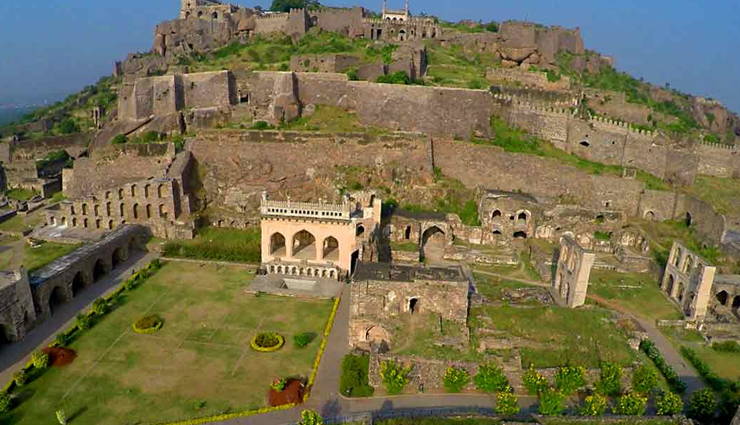
# Golconda Fort, Telangana
Golconda Fort, located in the state of Telangana, India, is a remarkable fortress known for its historical significance and architectural brilliance. Situated on a granite hilltop, about 11 kilometers from the city of Hyderabad, Golconda Fort stands as a testament to the grandeur of the Qutb Shahi dynasty, who ruled the region from the 16th to the 17th century.
The construction of Golconda Fort began in the 12th century, but it was the Qutb Shahi rulers who transformed it into a magnificent fort complex. The fort served as the capital and stronghold of the Qutb Shahi dynasty and played a significant role in the region's history, serving as a center of trade, administration, and military defense.
Golconda Fort is known for its ingenious architecture, advanced defense systems, and exquisite palaces. Here are some key features and attractions within the fort:
- Fortification and Gates: The fort is surrounded by massive ramparts and walls, stretching over 7 kilometers in length. It has several gates, including the Fateh Darwaza (Victory Gate), the main entrance known for its acoustic effects that allowed announcements to be heard at a distance.
- Bala Hisar: This is the highest point within the fort complex, offering panoramic views of the surrounding area. It was used as a signaling point and as a military defense structure.
- Rani Mahal: This palace was the residence of the royal women, including the queen and princesses. It features intricate carvings, beautiful arches, and ornamental designs.
- Taramati Mosque: Located atop a hill, this mosque is named after the legendary courtesan Taramati, who used to perform here. It is an impressive structure with beautiful arches and minarets.
- Sound and Light Show: Golconda Fort hosts a mesmerizing sound and light show in the evenings, narrating the history and legends associated with the fort. The show brings the fort's glorious past to life and is a popular attraction for visitors.
- Ramadasu's Jail: This structure is associated with the legendary Bhakti poet-saint Kancharla Gopanna, popularly known as Bhakta Ramadasu. It is believed that he was imprisoned here for misusing government funds to build a temple.
Golconda Fort is also renowned for its unique acoustic system. The fort has a remarkable feature called the "clapping hands' spot," where a clap made at a specific point near the entrance gate can be heard clearly at the top of the fort, almost 1 kilometer away.
Visiting Golconda Fort offers a fascinating journey through history, allowing you to explore its impressive architecture, experience the grandeur of the Qutb Shahi era, and enjoy panoramic views of the city of Hyderabad. It is a must-visit destination for history buffs, architecture enthusiasts, and anyone interested in the cultural heritage of Telangana.

# Jaisalmer Fort, Jaisalmer
Jaisalmer Fort, also known as Sonar Quila or the Golden Fort, is a magnificent fortress located in the city of Jaisalmer in the state of Rajasthan, India. It is one of the largest fully preserved fortified cities in the world and stands as a proud symbol of the rich cultural heritage of Rajasthan.
Constructed in the 12th century by Rawal Jaisal, the fort served as a strategic stronghold on the ancient trade route between India and Central Asia. The fort's golden-hued sandstone walls give it a mesmerizing appearance, especially during sunset when it glows like a golden jewel in the desert landscape.
Jaisalmer Fort is characterized by its imposing walls, intricate architecture, and a labyrinth of narrow lanes lined with houses, temples, shops, and havelis (mansions). Here are some key features and attractions within the fort:
- Jain Temples: The fort houses several beautifully carved Jain temples that are adorned with exquisite sculptures and intricate architectural details. The most prominent among them are the Rishabhadeva Temple, Chandraprabhu Temple, and the Parsvanath Temple.
- Raj Mahal (Royal Palace): The Raj Mahal was once the residence of the ruling Maharawals (kings) of Jaisalmer. It features ornate balconies, delicately carved windows, and stunning archways. Today, it houses a museum showcasing artifacts and displays related to the history and culture of Jaisalmer.
- Laxminath Temple: Dedicated to Lord Vishnu and Goddess Lakshmi, this temple is an important religious site for the local community. It is known for its beautifully carved pillars and intricate artwork.
- Havelis: The fort is home to numerous havelis, which are elaborately decorated mansions built by wealthy merchants and noble families. Patwon Ki Haveli, Nathmal Ji Ki Haveli, and Salim Singh Ki Haveli are notable examples. These havelis display exquisite craftsmanship, intricate carvings, and intricate frescoes.
- Fort Walls and Gates: The fort is encircled by massive sandstone walls that stretch for about 3 kilometers. It has four main gates: Ganesh Pol, Suraj Pol, Bhoot Pol, and Hava Pol. These gates are intricately carved and provide access to the bustling streets and markets within the fort.
Exploring Jaisalmer Fort allows you to immerse yourself in the rich history, vibrant culture, and architectural marvels of Rajasthan. The fort offers panoramic views of the golden city of Jaisalmer, surrounding sand dunes, and the Thar Desert. It is also a hub of vibrant activities, with shops selling local handicrafts, textiles, and jewelry, as well as cafes and rooftop restaurants offering breathtaking views.
Visiting Jaisalmer Fort is like stepping back in time and experiencing the grandeur of a bygone era. It is a must-visit destination for travelers seeking to explore Rajasthan's rich cultural heritage and witness the timeless beauty of a living fort.
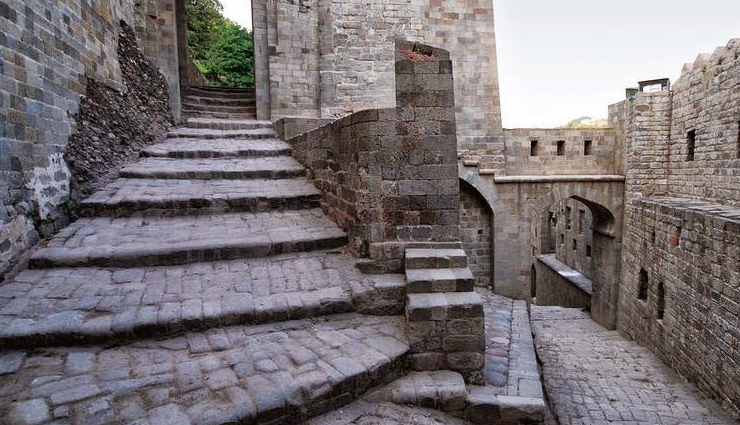
# Kangra Fort, Kangra
Kangra Fort, located in the town of Kangra in the state of Himachal Pradesh, India, is a historic fortress that holds immense cultural and architectural significance. It is one of the oldest forts in India and stands as a testament to the rich heritage of the region.
The construction of Kangra Fort dates back over a thousand years, with its origins believed to trace back to the ancient Trigarta Kingdom mentioned in the Mahabharata. The fort was ruled by various dynasties, including the Katoch dynasty, who played a prominent role in the history of the region.
Kangra Fort is situated atop a hill, providing a commanding view of the surrounding Kangra Valley and the Dhauladhar Range of the Himalayas. It is known for its massive walls, intricate architecture, and a series of gates that guard its entrance. Here are some key features and attractions within the fort:
- Raja's Palace: The Raja's Palace, also known as the Sheesh Mahal or the Palace of Mirrors, is a notable structure within the fort. It was the residence of the Katoch rulers and showcases beautiful frescoes, intricate carvings, and stunning mirror work.
- Temples: The fort complex houses several ancient temples, including the Ambika Devi Temple, Lakshmi Narayan Temple, and Adinath Temple. These temples exhibit a blend of architectural styles, from traditional Hindu temple architecture to influences from the Kangra School of Art.
- Vajreshwari Temple: Situated near the entrance of the fort, this temple is dedicated to Vajreshwari Devi, a manifestation of the Hindu goddess Durga. It is considered a sacred site and attracts devotees from far and wide.
- Viewpoints: Kangra Fort offers breathtaking panoramic views from various viewpoints within its premises. These viewpoints allow visitors to admire the scenic beauty of the Kangra Valley and the snow-capped peaks of the Dhauladhar Range.
Kangra Fort has a rich history and has witnessed several battles and invasions over the centuries. It has been captured and plundered by various rulers, including Mahmud of Ghazni and the Mughals. Despite its turbulent past, the fort has undergone restoration efforts to preserve its architectural heritage.
Visiting Kangra Fort provides a glimpse into the glorious past of the Kangra region and offers a serene and tranquil atmosphere. The fort's architectural splendor, ancient temples, and panoramic vistas make it a popular destination for history enthusiasts, architecture lovers, and nature admirers.
The town of Kangra, located in close proximity to the fort, also offers opportunities to explore nearby attractions such as the Masroor Rock Cut Temples, Brajeshwari Devi Temple, and the beautiful tea gardens of Palampur.
A visit to Kangra Fort allows you to delve into the rich history, experience the architectural marvels, and soak in the natural beauty of the Kangra Valley, making it a memorable destination in Himachal Pradesh.

# Jaigarh Fort, Jaipur
Jaigarh Fort, located on the outskirts of Jaipur, the capital city of Rajasthan, India, is a magnificent fortress known for its architectural grandeur and historical significance. Perched on the Aravalli Hills, it offers panoramic views of the surrounding landscape and the city of Jaipur.
Built in the 18th century by Maharaja Jai Singh II, the fort was primarily designed as a military structure to protect the Amer Fort and the city of Jaipur. It served as a strategic defense outpost and was known for housing weapons, artillery, and other military facilities.
Jaigarh Fort is renowned for its impressive fortifications, expansive courtyards, and a series of palaces and temples within its premises. Here are some key features and attractions of Jaigarh Fort:
- Jaivana Cannon: The fort is home to the world's largest cannon on wheels, known as Jaivana Cannon. It was cast during the reign of Maharaja Sawai Jai Singh II and has never been fired. The cannon stands as a testament to the technological advancements of that era.
- Ramparts and Watchtowers: The fort is surrounded by thick walls and watchtowers, offering a strategic advantage in terms of defense. These fortifications provide breathtaking views of the surrounding landscape, including the Amer Fort and the Maota Lake.
- Museum: Jaigarh Fort houses a museum that displays a collection of artifacts, weapons, photographs, and other historical objects. The museum provides insights into the royal history of Jaipur and the military prowess of the Kachwaha dynasty.
- Diya Burj: Diya Burj, also known as the Watchtower of Victory, is a prominent structure within the fort. It served as an observatory and provided a vantage point to monitor the activities in the surrounding areas.
- Palaces: The fort complex features several palaces, including the Laxmi Vilas, Lalit Mandir, and Aram Mandir. These palaces showcase intricate architecture, beautiful frescoes, and delicate carvings.
- Water Supply System: Jaigarh Fort has an advanced water supply system that consists of reservoirs and channels to ensure a continuous water supply to the fort. The most prominent among them is the Ganga Pol, a unique gateway that was used to bring water from the Ganga River.
Visiting Jaigarh Fort allows you to immerse yourself in the rich history of the Kachwaha dynasty and the valor of the Rajput warriors. The fort offers a glimpse into the military strategies, architectural brilliance, and royal lifestyle of the bygone era. It is also an excellent place to witness the stunning beauty of Jaipur and its surroundings.
Combined with a visit to the nearby Amer Fort and Nahargarh Fort, Jaigarh Fort completes the trio of magnificent forts that dominate the Jaipur skyline. Exploring Jaigarh Fort is a captivating experience that transports you back in time, providing a deeper understanding of Rajasthan's regal heritage.





